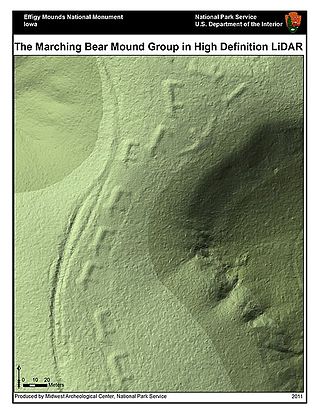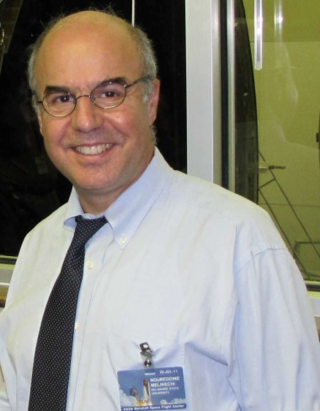Related Research Articles

The Defense Advanced Research Projects Agency (DARPA) is a research and development agency of the United States Department of Defense responsible for the development of emerging technologies for use by the military.

A laser is a device that emits light through a process of optical amplification based on the stimulated emission of electromagnetic radiation. The term is an acronym for light amplification by stimulated emission of radiation. The first laser was built in 1960 by Theodore Maiman at Hughes Research Laboratories, based on theoretical work by Charles H. Townes and Arthur Leonard Schawlow.

Lidar is an acronym of "light detection and ranging" or "laser imaging, detection, and ranging". It is a method for determining ranges by targeting an object or a surface with a laser and measuring the time for the reflected light to return to the receiver. It is sometimes called 3-D laser scanning, a special combination of 3-D scanning and laser scanning. LIDAR has terrestrial, airborne, and mobile applications.

Photonics is a branch of optics that involves the application of generation, detection, and manipulation of light in form of photons through emission, transmission, modulation, signal processing, switching, amplification, and sensing. Though covering all light's technical applications over the whole spectrum, most photonic applications are in the range of visible and near-infrared light. The term photonics developed as an outgrowth of the first practical semiconductor light emitters invented in the early 1960s and optical fibers developed in the 1970s.

Theodore Harold Maiman was an American engineer and physicist who is widely credited with the invention of the laser. Maiman's laser led to the subsequent development of many other types of lasers. The laser was successfully fired on May 16, 1960. In a July 7, 1960 press conference in Manhattan, Maiman and his employer, Hughes Aircraft Company, announced the laser to the world. Maiman was granted a patent for his invention, and he received many awards and honors for his work. His experiences in developing the first laser and subsequent related events are recounted in his book, The Laser Odyssey, republished recently under a new title The Laser Inventor: Memoirs of Theodore H. Maiman.

Phoenix was an uncrewed space probe that landed on the surface of Mars on May 25, 2008, and operated until November 2, 2008. Phoenix was operational on Mars for 157 sols. Its instruments were used to assess the local habitability and to research the history of water on Mars. The mission was part of the Mars Scout Program; its total cost was $420 million, including the cost of launch.
The MIT Lincoln Laboratory, located in Lexington, Massachusetts, is a United States Department of Defense federally funded research and development center chartered to apply advanced technology to problems of national security. Research and development activities focus on long-term technology development as well as rapid system prototyping and demonstration. Its core competencies are in sensors, integrated sensing, signal processing for information extraction, decision-making support, and communications. These efforts are aligned within ten mission areas. The laboratory also maintains several field sites around the world.

Novosibirsk State University is a public research university located in Novosibirsk, Russia. The university was founded in 1958, on the principles of integration of education and science, early involvement of students with research activities and the engagement of leading scientists in its teaching programmes.

Chandra Kumar Naranbhai Patel (born 2 July 1938) is an electrical engineer. He developed the carbon dioxide laser in 1963; it is now widely used in industry for cutting and engraving a wide range of materials like plastic and wood. Because the atmosphere is quite transparent to infrared light, CO2 lasers are also used for military rangefinding using LIDAR techniques.

Robert D. Richards is a Canadian-born space entrepreneur. He is co-founder and CEO of Moon Express, Inc., a U.S. company partnered with NASA and developing robotic spacecraft to provide low cost access to the Moon for science, exploration and commerce. He is also the founder and former CEO of Odyssey Moon Limited, an Isle of Man based commercial lunar enterprise and the first official contender in the $30M Google Lunar X PRIZE competition. From 2002-2009 he was the founding Director of the Space Division at Optech Incorporated, providing advanced lidar systems for spacecraft operations and planetary exploration, including NASA's Mars Phoenix Lander and OSIRIS-REx missions.
Teledyne Optech is a for-profit company operating since 1974, and focusing on Laser-based survey systems. It started as Optech Incorporated, and was purchased by Teledyne Technologies in 2015.
Laser Science and Technology Centre (LASTEC) is a laboratory of the Defence Research & Development Organization (DRDO). Located in Delhi, it is the main DRDO lab involved in the development of Lasers and related technologies. LASTEC functions under the DRDO Directorate of Electronics & Computer Science.

Paul F. McManamon is an American scientist who is best known for his work in optics and photonics, as well as sensors, countermeasures, and directed energy.

Phobos And Deimos & Mars Environment (PADME) is a low-cost NASA Mars orbiter mission concept that would address longstanding unknowns about Mars' two moons Phobos and Deimos and their environment.
Atmospheric lidar is a class of instruments that uses laser light to study atmospheric properties from the ground up to the top of the atmosphere. Such instruments have been used to study, among other, atmospheric gases, aerosols, clouds, and temperature.

Noureddine Melikechi, D.Phil is an Algerian atomic, molecular, and optical physicist, educator and inventor. He is the author of more than 125 peer-reviewed publications, three book chapters and 15 patents. Melikechi is a member of the Mars Science Laboratory, NASA’s largest Mars exploration effort to date.
Michael H. Hecht is a research scientist, associate director for research management at the Massachusetts Institute of Technology's Haystack Observatory, and former deputy project director of the Event Horizon Telescope. He served as lead scientist for the Microscopy, Electrochemistry, and Conductivity Analyzer instrument on the Phoenix Mars lander, and as principal investigator for the Mars Oxygen ISRU Experiment (MOXIE) instrument on the Mars 2020 rover.
Deborah J. Jackson is an American physicist and Program Manager at the National Science Foundation, and a Fellow of the National Society of Black Physicists. She was the first African American woman to receive a Ph.D. in physics from Stanford University. She is an expert on "electromagnetic phenomena" with a research and development career that spans the full range of the electromagnetic spectrum from materials studies using hard x-ray wavelengths, to nonlinear optics and spectroscopy in the near-infrared, to the fielding of radio frequency instrumentation on deep space missions such as Cassini and Mars Observer.
The Buckeye system is an operational airborne surveying system that provides high-resolution spatial imagery over an area of interest to support military operations involved with intelligence, surveillance, and reconnaissance. Once mounted on a helicopter or an unmanned aerial vehicle (UAV), it incorporates visual information from a digital camera and elevation data from a Light Detection and Ranging (LIDAR) system to create a two and three-dimensional colored map with orthorectified, 4 to 6-inch resolution.
Michel Meunier is a professor of engineering physics and biomedical engineering at Polytechnique Montréal, a position has he held since 1986. He was recently the acting director of the Department of Engineering Physics from 2019 to 2020. He is the director of the Laser Processing and Plasmonics Laboratory (LP2L), which he founded in 1988, whose mission is to develop diagnostic and therapeutic technologies based on plasmonics and the optical properties of colloidal nanoparticles.
References
- ↑ "CSA - Partners". Archived from the original on 2007-12-05. Retrieved 2007-08-05.
- ↑ Phoenix Mars Mission – Mission – Teams – Allan Carswell
- ↑ "RSC: The Academies of Arts, Humanities and Sciences of Canada : Membership". Archived from the original on 2016-03-03. Retrieved 2007-08-21.
- ↑ "Optech Inc". Archived from the original on 2012-02-08. Retrieved 2007-08-05.